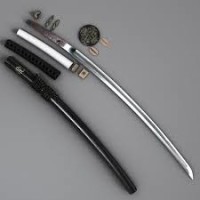Learning about Katana parts can be overwhelming with all of the Japanese terminology involved. This Katana terminology guide will help readers to learn the different names of the Katana parts, and how they go together.
Blade Katana Parts
Kissaki– The kissaki is the end of the blade, where the sharpened edge curves to a point.
Hamon– The hamon is a line formed during the tempering process. The swordsmith decides how it is shaped, making it a distinctive part of each blade. There are different types of hamon, with different names.
Boshi– The boshi is the part of the hamon that covers the kissaki. Their shapes can differ from the hamon, but they are usually similar.
Yokote– The yokote is the line that separates the kissaki from the rest of the blade.
Yakiba– The yakiba is the hard part of the blade, the cutting edge. Blades are differentially hardened to allow shock absorption and avoid brittleness.
Shinogi–ji– The shinogi-ji is a flat ridge on the blade’s back.
Hada– The hada is the middle part of the blade.
Shinogi– The shinogi is the line separating the shinogi-ji from the hada.
Mune– The mune is the back of the blade.
Ji– The ji is the surface between shinogi and hamon.
Ha– The ha is the sharpened, cutting edge.
Hi– The hi is an optional groove that goes down the shinogi-ji on both sides. It lightens the blade, which takes some power out of the sword’s blows. It is said the hi makes a certain type of noise when the sword is swung perfectly, so some would use it as a guide.
Nakago– The nakago is the tang, the part of the blade that fits inside of the handle. It is unsharpened and will have one or two peg-holes, called mekugi-ana.
Ha-machi– The ha-machi is a notch located on the front of the sword. This is the beginning of the sword’s tempered edge.
Mune-machi– The mune-machi is the notch on the back of the sword that marks the beginning of the tempered edge. The sword’s length is measured from this notch to the point of the sword in a straight line.
Horimono– The horimono is an optional carving on the shinogi-ji, close to the mune-machi. It can protrude to the rest of the blade, and can be a design or writing.
Mei– The mei is the inscribed signature of the swordsmith who made the blade. Most mei only include the family name of the swordsmith.
Did you get all that? Now let us take a look at the tsuka(the handle) Katana Parts
Kashira– The kashira is the pommel cap of the sword.
Ho– The ho is the handle, made up of two snugly-fit pieces of bamboo, with a hole that lines up with the mekugi-ana on the nakago.
Mekugi– The mekugi is the small bamboo peg that goes through the holes on the ho and nakago. It keeps everything tight, so there is no rattling.
Same– The same is the shark or rayskin wrap around the handle. Low-end swords will typically use less expensive alternatives.
Menuki– The menuki is a pair of elaborate ornaments on either side of the tsuka. Some swords omit them or only use one, but a sword cannot truly be a katana without them.
Tsuka Ito– The tsuka ito is the characteristic braid of material wrapped in a diamond pattern around the handle. The menuki can be seen in one of these diamond-shaped gaps. It’s used to hold the tsuka together and for a good grip.
Fuchi– The fuchi is a metal piece that fits tightly on top of the ho, holding it together. It is typically made of the same material as the menuki.
Tsuba– The tsuba is the guard atop the the handle. The tsuba is usually round, but can be any shape. They are very ornate and can be intricately designed; some tsuba even tell a story.
Seppa– The seppa are rings of metal that fit above and below the tsuba to hold it in place.
Habaki– The habaki is a metal sleeve which is fitted to the mouth of the saya(scabbard), so that the sword does not come out unintentionally.


